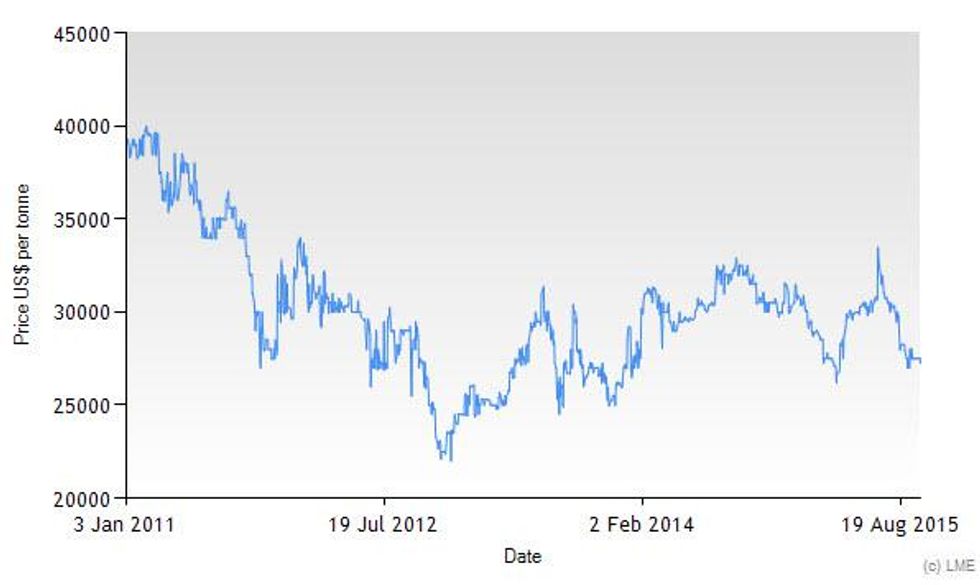
Chris Berry of House Mountain Partners and the Disruptive Discoveries Journal weighs in on what the stagnant cobalt price could mean for investors.
By Chris Berry (@cberry1)
Originally published by the Disruptive Discoveries Journal on October 2, 2015. For a PDF version of this note, please click here.
Regular readers will know of my optimism regarding cobalt. The fundamentals look sound in a metals market that, already under pressure, appears headed lower. To wit:
- Cobalt demand is growing by 6% overall with demand in the battery supply chain growing by some estimates at a CAGR of 10% out to 2020. Current estimates for battery usage put the actual tonnage demanded at between 35,000 and 40,000 tpy – a good chunk of the overall market. This is driven almost exclusively by cobalt’s use in the cathode of the lithium ion battery.
- Cobalt is mainly a by-product, produced as a consequence of nickel and copper mining rendering cobalt production hostage to the bullish or bearish tendencies of these other metals.
- Major cobalt producers such as Glencore (GLEN:LON) and Freeport McMoRan (FCX:NYSE) are taking a substantial chunk of cobalt supply off the market by slashing copper production to repair their balance sheets. GLEN recently announced the suspension of copper/cobalt production from its African operations for 18 months. This will take 400,000 t of copper off the market. More importantly, GLEN produced 8,100 tonnes of cobalt during the first half of 2015 which would put it at a run rate to be around 16% of the global cobalt supply. This will also presumably be halted.
- As cobalt barely registers on the income statements of these multi-billion dollar market cap companies, it seems capacity expansion is unlikely as cobalt doesn’t “move the needle”.
- Other companies, however, see the market differently as ENRC has plans to emerge as a major cobalt producer in the next two years.
- According to a recent report by the IEA, renewable energy will be the largest source of power generation installed worldwide over the next five years, totaling 700 GW. Though there is no direct correlation to cobalt here, the use of batteries for energy storage would seem to be a given, bolstering the case for increased cobalt use.
- Despite the best efforts of battery and materials scientists, cobalt use in the cathode has yet to be replaced or substituted in its entirety owing to cobalt’s unique properties. While numerous chemistries exist, NCA (nickel cobalt aluminum) and NMC (nickel manganese cobalt) are the most widely accepted for different reasons. This could obviously change if cobalt prices rise substantially and the cobalt market enters a structural deficit, but this won’t happen overnight.
- Though a large percentage of cobalt is refined in China, cobalt demand is NOT dependent on the China growth story in the same way nickel or lead is.
- According to Macquarie, compared to all metals used in lithium ion battery manufacturing, cobalt has the largest use as a percent of its overall market demand. The bank states, “Panasonic, who produce 1.5bn lithium ion batteries per annum, have reported their metals consumption to be 5,000t of cobalt, which just for this single company accounts for 5.7% of the global cobalt market. In terms of the other metals used, nickel (0.3% of global demand) and copper (<.1%) barely register, while even the 8,400t lithium carbonate used only equates to 4.9% of global demand.”
All of these bullish indicators would have you think that the cobalt price has strengthened. As the chart below shows, this isn’t the case. Why?
There are likely several reasons for this, including stockpiling in China and ample cobalt stocks on the LME.
However, likely a more pressing issue and one overlooked, in my opinion, is the general disinflationary trend in the global economy. The horrendous jobs numbers in the US this morning were only the latest indication of a slowing global economy. Not only did the jobs numbers come in well below economist expectations (seasonally adjusted 142,000 versus 200,000), but previous month’s numbers were revised downwards and the labor force participation rate continues to plummet to a 38 year low.
More broadly, deflationary trends in China, Japan, and the Euro Zone all, when combined, seem to bolster the idea that no commodity is immune from pricing pressures, irrespective of rosy current and future demand projections.
I remain optimistic on looming structural tightness in the cobalt market, but look at the stagnant cobalt price as a cautionary tale more than anything. There will always be threats to an investment thesis. In the case of cobalt, substitution, high stocks at the LME, or discovery of additional cobalt stocks in China as we saw with nickel should give us pause. The point here isn’t to panic, but instead, take a more holistic view of the macro economy and decide where you want to position yourself on the lithium ion battery supply chain. While stagnant metals prices may spell trouble for current and potential cobalt producers (I still think cost of production trumps price), they are decidedly more positive for those end users of cobalt further down the supply chain who can expand margins through lower raw materials costs.
Chris is an independent analyst focused on strategic metals, innovation, and associated supply chain dynamics. After spending 15 years working across various roles in sales and brokerage on Wall Street, Chris shifted his attention to the forces propelling lifestyle convergence including urbanization, innovation, and technology and the opportunities that they are creating across numerous industries.
He has spoken at conferences all over the world and has visited dozens of countries first hand to gauge the pace of change in these topics as he thinks they are forces set to dramatically alter our way of life.
Chris has additional experience as the co-founder of a start up for investors which dealt with “computing with words” and co-authors The Disruptive Discoveries Journal. Chris holds a Master of Business Administration in finance with an international focus from Fordham University, and a Bachelor of Arts in international studies from The Virginia Military Institute.
He can be reached at info@discoveryinvesting.com
Editorial Disclosure: This article was originally published by the Disruptive Discoveries Journal. The Investing News Network was not paid for this content. Please see the author’s disclosure below.
The material herein is for informational purposes only and is not intended to and does not constitute the rendering of investment advice or the solicitation of an offer to buy securities. The foregoing discussion contains forward-looking statements within the meaning of the Private Securities Litigation Reform Act of 1995 (The Act). In particular when used in the preceding discussion the words “plan,” confident that, believe, scheduled, expect, or intend to, and similar conditional expressions are intended to identify forward-looking statements subject to the safe harbor created by the ACT. Such statements are subject to certain risks and uncertainties and actual results could differ materially from those expressed in any of the forward looking statements. Such risks and uncertainties include, but are not limited to future events and financial performance of the company which are inherently uncertain and actual events and / or results may differ materially. In addition we may review investments that are not registered in the U.S. We cannot attest to nor certify the correctness of any information in this note. Please consult your financial advisor and perform your own due diligence before considering any companies mentioned in this informational bulletin.
The information in this note is provided solely for users’ general knowledge and is provided “as is”. We at the Disruptive Discoveries Journal make no warranties, expressed or implied, and disclaim and negate all other warranties, including without limitation, implied warranties or conditions of merchantability, fitness for a particular purpose or non-infringement of intellectual property or other violation of rights. Further, we do not warrant or make any representations concerning the use, validity, accuracy, completeness, likely results or reliability of any claims, statements or information in this note or otherwise relating to such materials or on any websites linked to this note. I own no shares in any companies mentioned in this note.
The content in this note is not intended to be a comprehensive review of all matters and developments, and we assume no responsibility as to its completeness or accuracy. Furthermore, the information in no way should be construed or interpreted as – or as part of – an offering or solicitation of securities. No securities commission or other regulatory authority has in any way passed upon this information and no representation or warranty is made by us to that effect. For a more detailed disclaimer, please click here.



